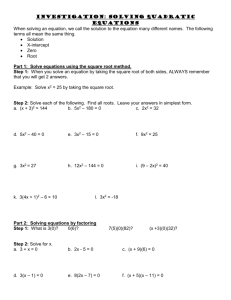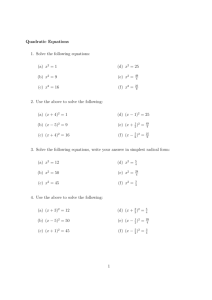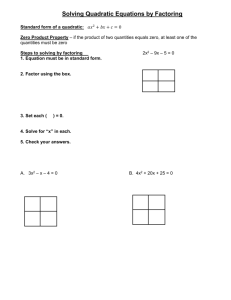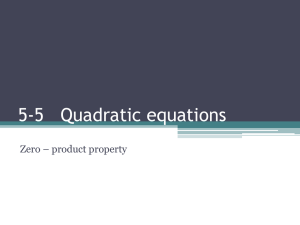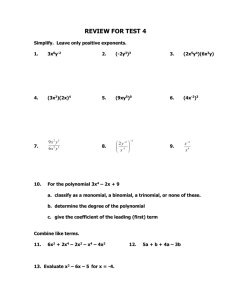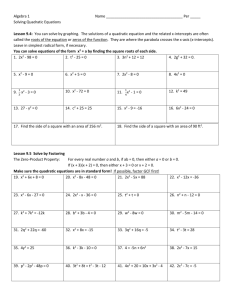Complex Numbers (a + bi)
advertisement
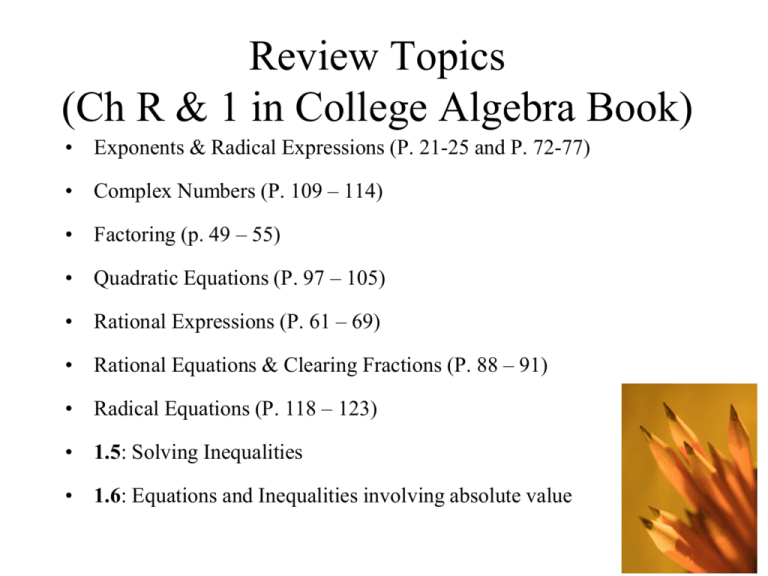
Review Topics
(Ch R & 1 in College Algebra Book)
• Exponents & Radical Expressions (P. 21-25 and P. 72-77)
• Complex Numbers (P. 109 – 114)
• Factoring (p. 49 – 55)
• Quadratic Equations (P. 97 – 105)
• Rational Expressions (P. 61 – 69)
• Rational Equations & Clearing Fractions (P. 88 – 91)
• Radical Equations (P. 118 – 123)
• 1.5: Solving Inequalities
• 1.6: Equations and Inequalities involving absolute value
Review of Exponents
82 =8 • 8 = 64
24 = 2 • 2 • 2 • 2 = 16
x2 = x • x
Base = x
Exponent = 2
x4 = x • x • x • x
Base = x
Exponent = 4
Exponents of 1
Anything to the 1 power is itself
51 = 5
Zero Exponents
Anything to the zero power = 1
x1 = x (xy)1 = xy
50 = 1
x0 = 1
(xy)0 = 1
Negative Exponents
5-2 = 1/(52) = 1/25
x-2 = 1/(x2)
xy-3 = x/(y3)
a-n = 1/an
1/a-n = an
a-n/a-m = am/an
(xy)-3 = 1/(xy)3 = 1/(x3y3)
Powers with Base 10
100 = 1
101 = 10
102 = 100
103 = 1000
104 = 10000
The exponent is the same as the
number of 0’s after the 1.
100 = 1
10-1 = 1/101
10-2 = 1/102
10-3 = 1/103
10-4 = 1/104
= 1/10
= 1/100
= 1/1000
= 1/10000
= .1
= .01
= .001
= .0001
The exponent is the same as the number
of digits after the decimal where 1 is placed
Scientific Notation uses the concept of powers with base 10.
Scientific Notation is of the form: __. ______ x 10
(** Note: Only 1 digit to the left of the decimal)
You can change standard numbers to scientific notation
You can change scientific notation numbers to standard numbers
Scientific Notation
Scientific Notation uses the concept of powers with base 10.
5 ______
321
Scientific Notation is of the form: __.
x 10
(** Note: Only 1 digit to the left of the decimal)
-2
Changing a number from scientific notation to standard form
5.321
Step 1: Write the number down without the 10n part.
Step 2: Find the decimal point
Step 3: Move the decimal point n places in the
‘number-line’ direction of the sign of the exponent.
.05321
Step 4: Fillin any ‘empty moving spaces’ with 0.
Changing a number from standard form to scientific notation
Step1: Locate the decimal point.
Step 2: Move the decimal point so there is 1 digit to the left of the decimal.
Step 3: Write new number adding a x 10n where n is the # of digits moved left
adding a x10-n where n is the #digits moved right
.0 5 3 2 1
= 5.321 x 10-2
Raising Quotients to Powers
a
b
n
Examples:
an
= bn
-n
a
b
2
3
4
32
42
=
2x
y
2x
y
3
=
=
bn
an
= b
a
9
= 16
3
(2x)
= 3 =
y
-3
=
a-n
b-n
(2x)-3
=
y-3
8x3
y3
1
y-3(2x)3
=
y3
y3
(2x)3 = 8x3
n
Product Rule
am • an = a(m+n)
x3 • x5 = xxx • xxxxx = x8
x-3 • x5 = xxxxx = x2 = x2
xxx
1
x4 y3 x-3 y6 = xxxx•yyy•yyyyyy = xy9
xxx
3x2 y4 x-5 • 7x = 3xxyyyy • 7x = 21x-2 y4 = 21y4
xxxxx
x2
Quotient Rule
am = a(m-n)
an
43 = 4 • 4 • 4 = 41 = 4
42
4•4
43 = 64
42
16
x5 = xxxxx = x3
x2
xx
x5 = x(5-2) = x3
x2
15x2y3 = 15 xx yyy = 3y2
5x4y
5 xxxx y
x2
3a-2 b5 = 3 bbbbb bbb = b8
9a4b-3
9aaaa aa
3a6
= 8
2
= 4
15x2y3 = 3 • x -2 • y2 = 3y2
5x4y
x2
3a-2 b5
9a4b-3
= a(-2-4)b(5-(-3)) = a-6 b8 = b8
3
3
3a6
Powers to Powers
(am)n = amn
(a2)3 a2 • a2 • a2 = aa aa aa = a6
(24)-2 = 1
(24)2
(x3)-2 = x –6
(x -5)2 x –10
= 1
=1
= 1/256
24 • 24 16 • 16
= x 10 = x4
x6
(24)-2 = 2-8 = 1 = 1
28 256
Products to Powers
(ab)n = anbn
(6y)2 = 62y2 = 36y2
(2a2b-3)2 = 22a4b-6 = 4a4
= a
4(ab3)3
4a3b9
4a3b9b6
b15
What about this problem?
5.2 x 1014
3.8 x 105
= 5.2/3.8 x 109 1.37 x 109
Do you know how to do exponents on the calculator?
Square Roots & Cube Roots
A number b is a square root
of a number a if b2 = a
A number b is a cube root
of a number a if b3 = a
25 = 5 since 52 = 25
3
Notice that 25 breaks down into 5 • 5
So, 25 = 5 • 5
Notice that 8 breaks down into
3
2 • 2 • 2 So, 8 = 2 • 2 • 2
See a ‘group of 2’ -> bring it outside the
radical (square root sign).
See a ‘group of 3’ –> bring it outside
the radical (the cube root sign)
Example: 200 = 2 • 100
= 2 • 10 • 10
= 10 2
Note: -25 is not a real number since no
number multiplied by itself will be negative
8 = 2 since 23 = 8
3
3
Example: 200 = 2 • 100
3
= 2 • 10 • 10
3
= 2 • 5 • 2 • 5 • 2
3
= 2 • 2 • 2 • 5 • 5
3
= 2 25
3
Note: -8
IS a real number (-2) since
-2 • -2 • -2 = -8
Nth Root ‘Sign’ Examples
Even radicals of positive numbers
Have 2 roots. The principal root
Is positive.
16 = 4 or -4
-16 not a real number
-16 not a real number
-32
= -2
Odd radicals of negative numbers
Have 1 negative root.
32
= 2
Odd radicals of positive numbers
Have 1 positive root.
4
5
5
Even radicals of negative numbers
Are not real numbers.
Exponent Rules
(x ) x
m n
mn
x 1
0
(XY)m = xmym
x x x
m
n
m n
m
x
m n
x
n
x
m
X
Y
Xm
= m
Y
x
m
m
1
m
x
x x
1/ m
Examples to Work through
3
27
4
81
12
3
8x y
4
3
Product Rule and Quotient Rule
Example
8
8
5/ 4
1/ 4
8
3/ 4
Some Rules for Simplifying
Radical Expressions
n
a b ab
n
a a
n
a a
n
m
n
1/ n
m/n
Example Set 1
3
5 7
5
2 x 5 16 y
y
x
3
300
Example Set 2
3
16
54
4
512 x
4
Example Set 3
3
5t 3 125t
6
5
4t 5 8t
6
r
r
5
4 5 8
9 27
Operations on Radical Expressions
•Addition and Subtraction (Combining LIKE Terms)
•Multiplication and Division
• Rationalizing the Denominator
Radical Operations with
Numbers
3 2 4 2
2 16 5 54 10 2
3
3
3
Radical Operations with
Variables
3
3
8x 2 x
27
3
4
xy x y
5
4
5
2 3 z 3 12 z 3 48 z
Multiplying Radicals (FOIL
works with Radicals Too!)
( 2 x 3 y )( 2 x 3 y )
( x 9)( x 8)
Rationalizing the Denominator
• Remove all radicals from the denominator
1
2
xy
y
3
Rationalizing Continued…
• Multiply by the conjugate
1
32
3
32
Complex Numbers
REAL NUMBERS
Rational
Numbers
(1/2 –7/11, 7/9, .33
Integers
(-2, -1, 0, 1, 2, 3...)
Whole Numbers
(0,1,2,3,4...)
Natural Numbers
(1,2,3,4...)
Irrational
Numbers
, 8, -13
Imaginary Numbers
Complex Numbers
(a + bi)
Real Numbers
a + bi with b = 0
Rational
Numbers
Irrational
Numbers
Integers
Whole Numbers
Natural Numbers
Imaginary Numbers
a + bi with b 0
i = -1
where
i2= -1
Simplifying Complex Numbers
A complex number is simplified if it is in standard form:
a + bi
Addition & Subtraction)
Ex1: (5 – 11i) + (7 + 4i) = 12 – 7i
Ex2: (-5 + 7i) – (-11 – 6i) = -5 + 7i +11 + 6i = 6 + 13i
Multiplication)
Ex3: 4i(3 – 5i) = 12i –20i2 = 12i –20(-1) = 12i +20 = 20 + 12i
Ex4: (7 – 3i) (-2 – 5i) [Use FOIL]
-14 –35i +6i +15i2
-14 –29i +15(-1)
-14 –29i –15
-29 –29i
Complex Conjugates
The complex conjugate of (a + bi) is (a – bi)
The complex conjugate of (a – bi) is (a + bi)
(a + bi) (a – bi) = a2 + b2
Division
7 + 4i
2 – 5i
2 + 5i =
2 + 5i
14 + 35i + 8i + 20i2 = 14 + 43i +20(-1)
4 + 10i –10i – 25i2
4 –25(-1)
14 + 43i –20 = -6 + 43i = -6
43 i
+
4 + 25
29
29
29
Square Root of a Negative
Number
25 4 = 100 = 10
-25 -4 = (-1)(25) (-1)(4)
Optional Step
= (i2)(25) (i2)(4)
= i 25 i 4
= (5i) (2i) = 10i2 = 10(-1) = -10
Practice – Square Root of Negatives
1 i
4
16
12
Practice – Simplify Imaginary
Numbers
i0 =
i1 =
1
i
Another way to calculate in
i2 =
-1
i3 =
-i
Divide n by 4. If the remainder is r
then in = ir
i4 =
1
Example:
i11 = __________
i5 =
i
11/4 = 2 remainder 3
i6 =
-1
So, i11 = i3 = -i
Practice – Simplify More Imaginary
Numbers
i
15
i
26
i
100
i
203
Practice – Addition/Subtraction
(3 9i ) (7 i )
10 +8i
(3 9i ) (7 i )
-4 +10i
Practice – Complex Conjugates
• Find complex conjugate.
5 2i
3 4i
3i
=>
-4i
=>
Practice Division w/Complex
Conjugates
7 4i
4i
4__
2i
=
Adding & Subtracting Polynomials
Combine Like Terms
(2x2 –3x +7) + (3x2 + 4x – 2) =
5x2 + x + 5
(5x2 –6x + 1) – (-5x2 + 3x – 5) = (5x2 –6x + 1) + (5x2 - 3x + 5)
= 10x2 – 9x + 6
Types of Polynomials
f(x) = 3
f(x) = 5x –3
f(x) = x2 –2x –1
f(x) = 3x3 + 2x2 – 6
Degree 0
Degree 1
Degree 2
Degree 3
Constant Function
Linear
Quadratic
Cubic
Multiplication of Polynomials
Step 1: Using the distributive property, multiply every term in the
1st polynomial by every term in the 2nd polynomial
Step 2: Combine Like Terms
Step 3: Place in Decreasing Order of Exponent
4x2 (2x3 + 10x2 – 2x – 5) = 8x5 + 40x4 –8x3 –20x2
(x + 5) (2x3 + 10x2 – 2x – 5) = 2x4 + 10x3 – 2x2 – 5x
+ 10x3 + 50x2 – 10x – 25
= 2x4 + 20x3 + 48x2 –15x -25
Binomial Multiplication with FOIL
(2x + 3) (x - 7)
F.
(First)
O.
(Outside)
I.
(Inside)
L.
(Last)
(2x)(x)
(2x)(-7)
(3)(x)
(3)(-7)
3x
-21
2x2
-14x
2x2
-14x
2x2
+
- 11x
3x
-21
-21
Division by a Monomial
3x2 + x
x
4x2 + 8x – 12
4x2
15A2 – 8A2 + 12
4A
5x3 – 15x2
15x
5x2y + 10xy2
5xy
12A5 – 8A2 + 12
4A
Review: Factoring Polynomials
To factor a number such as 10, find
out
‘what times what’ = 10
10 = 5(2)
To factor a polynomial, follow a similar process.
Factor: 3x4 – 9x3 +12x2
3x2 (x2 – 3x + 4)
Another Example:
Factor 2x(x + 1) + 3 (x + 1)
(x + 1)(2x + 3)
Solving Polynomial Equations By
Factoring
Zero Product Property : If AB = 0 then A = 0 or B = 0
Solve the Equation: 2x2 + x = 0
Step 1: Factor
x (2x + 1) = 0
Step 2: Zero Product
x = 0 or
2x + 1 = 0
Step 3: Solve for X
x = 0 or
x= -½
Question: Why are there 2 values for x???
Factoring Trinomials
To factor a trinomial means to find 2 binomials whose product
gives you the trinomial back again.
Consider the expression: x2 – 7x + 10
The factored form is:
(x – 5) (x – 2)
Using FOIL, you can multiply the 2 binomials and
see that the product gives you the original trinomial expression.
How to find the factors of a trinomial:
Step 1: Write down 2 parentheses pairs.
Step 2: Do the FIRSTS
Step3 : Do the SIGNS
Step4: Generate factor pairs for LASTS
Step5: Use trial and error and check with FOIL
Practice
Factor:
1. y2 + 7y –30
2.
10x2 +3x –18
3. 8k2 + 34k +35
4. –15a2 –70a + 120
5. 3m4 + 6m3 –27m2
6. x2 + 10x + 25
Special Types of Factoring
Square Minus a Square
A2 – B2 = (A + B) (A – B)
Cube minus Cube and Cube plus a Cube
(A3 – B3) = (A – B) (A2 + AB + B2)
(A3 + B3) = (A + B) (A2 - AB + B2)
Perfect Squares
A2 + 2AB + B2 = (A + B)2
A2 – 2AB + B2 = (A – B)2
Quadratic Equations
General Form of Quadratic Equation
ax2 + bx + c = 0
a, b, c are real numbers & a 0
A quadratic Equation: x2 – 7x + 10 = 0
a = _____
1 b = _____
-7 c = ______
10
Methods & Tools for Solving Quadratic Equations
1. Factor
2. Apply zero product principle (If AB = 0 then A = 0 or B = 0)
3. Square root method
Example1:
Example 2:
4. Completing the Square x2 – 7x + 10 = 0
4x2 – 2x = 0
5. Quadratic Formula
(x – 5) (x – 2) = 0
2x (2x –1) = 0
x – 5 = 0 or x – 2 = 0
2x=0 or 2x-1=0
+5 +5
+2 +2
2 2
+1 +1
2x=1
x = 5
or
x= 2
x = 0 or x=1/2
Square Root Method
If u2 = d then u = d or u = - d. If u2 = d then u = + d
Solving a Quadratic Equation with the Square Root Method
Example 1:
Example 2:
4x2 = 20
(x – 2)2 = 6
4
4
x – 2 = +6
x2 = 5
+2 +2
x = + 5
So, x = 5 or - 5
x = 2 + 6
So, x = 2 + 6 or 2 - 6
Completing the Square
(Example 1)
If x2 + bx is a binomial then by adding b 2 which is the square of half
2
the coefficient of x, a perfect square trinomial results:
x2 + bx + b 2 = x + b 2
2
2
Solving a quadratic equation with ‘completing the square’ method.
Example:
x2 - 6x + 2 = 0
-2 -2
x2 - 6x = -2
x2 - 6x + 9 = -2 + 9
(x – 3)2 = 7
x – 3 = + 7
x = (3 + 7 ) or (3 - 7 )
Step1: Isolate the Binomial
Step 2: Find ½ the coefficient of x (-3 )
and square it (9) & add to both sides.
Note: If the coefficient of x2 is not 1 you
must divide by the coefficient of x2 before
completing the square. ex: 3x2 – 2x –4 = 0
(Must divide by 3 before taking ½ coefficient of x)
Step 3: Apply square root method
(Completing the Square – Example 2)
Step 1: Check the coefficient of the x2 term. If 1 goto step 2
If not 1, divide both sides by the coefficient of the x2 term.
Step 2: Calculate the value of : (b/2)2
[In this example: (2/2)2 = (1)2 = 1]
Step 3: Isolate the binomial by grouping the x2 and x term together, then
add (b/2)2 to both sides of he equation.
2 +4x – 1 = 0
2x
Step 4: Factor & apply square root method
2x2 +4x – 1 = 0
2
2 2 2
(x + 1) (x + 1) = 3/2
(x + 1)2 = 3/2
x2 +2x – 1/2 = 0
(x2 +2x
)=½
(x2 +2x + 1 ) = 1/2 + 1
√(x + 1)2 = √3/2
x + 1 = +/- √6/2
x = √6/2 – 1 or - √6/2 - 1
Quadratic Formula
General Form of Quadratic Equation:
ax2 + bx + c = 0
Quadratic Formula: x = -b + b2 – 4ac
2a
discriminant: b2 – 4ac
if 0, one real solution
if >0, two unequal real solutions
if <0, imaginary solutions
Solving a quadratic equation with the ‘Quadratic Formula’
2x2 – 6x + 1= 0
_______
2
a = ______
-6
b = ______
x = - (-6) + (-6)2 – 4(2)(1)
2(2)
= 6 + 36 –8
4
= 6 + 28
4
= 6 + 27
4
= 2 (3 + 7 ) = (3 + 7 )
4
2
c=
1
Solving Higher Degree Equations
x3 = 4x
2x3 + 2x2 - 12x = 0
x3 - 4x = 0
x (x2 – 4) = 0
x (x – 2)(x + 2) = 0
2x (x2 + x – 6) = 0
x=0
2x (x + 3) (x – 2) = 0
x–2=0 x+2=0
2x = 0 or
x + 3 = 0 or x – 2 = 0
x=2
x=0
x = -3 or
x = -2
or
x=2
Solving By Grouping
x3 – 5x2 – x + 5 = 0
(x3 – 5x2) + (-x + 5) = 0
x2 (x – 5) – 1 (x – 5) = 0
(x – 5)(x2 – 1) = 0
(x – 5)(x – 1) (x + 1) = 0
x–5=0
or
x-1=0
or
x+1=0
x=5
or
x=1
or
x = -1
Rational Expressions
Rational Expression – an expression in which a polynomial is divided by
another nonzero polynomial.
Examples of rational expressions
4
x
x
2x – 5
Domain = {x | x 0}
Domain = {x | x 5/2}
2
x–5
Domain = {x | x 5}
Multiplication and Division of
Rational Expressions
A • C = A
B • C
B
9x
3x2
5y – 10 = 5 (y – 2)
10y - 20
10 (y – 2)
2z2 – 3z – 9
z2 + 2z – 15
A2 – B2
A+B
3
x
= 5 =1
10
2
= (2z + 3) (z – 3)
(z + 5) (z – 3)
=
=
(A + B)(A – B)
(A + B)
= 2z + 3
z+5
= (A – B)
Negation/Multiplying by –1
-y – 2
4y + 8
=
y+2
4y + 8
OR
-y - 2
-4y - 8
Examples
x3 – x
x–1
(x3 – x) (x + 1)
=
x(x – 1)
= x (x2 – 1)(x + 1)
x(x – 1)
= x (x + 1) (x – 1)(x + 1)
x(x – 1)
=
x2 – 25
x2 –10x + 25
2
x + 5x + 4
2x2 + 8x
• x+1
x
(x + 1)(x + 1) = (x + 1)2
=
x2 – 25
x2 + 5x + 4
•
2x2 + 8x
x2 –10x + 25
(x + 5) (x – 5) • 2x(x + 4)
= (x + 4)(x + 1) • (x – 5) (x – 5)
2x (x + 5)
= (x + 1)(x – 5)
Check Your Understanding
Simplify:
Simplify:
x2 –6x –7
x2 -1
1
x-2
6
(x + 1) (x –7)
(x + 1) (x – 1)
(x – 7)
(x – 1)
1
x–2
1
x–2
3
x2 + x x2 + x - 6
3
•
•
(x + 3)
3
(x + 3) (x – 2)
3
Addition of Rational Expressions
Adding rational expressions is like adding fractions
With LIKE denominators:
1
8
+
x
x+2
x
3x2 + 4x - 4
2
8
+
+
=
3x - 1
x+2
=
3
8
4x - 1
x+2
2
(2 + x)
(2 + x)
=
=
3x2 + 4x -4
(3x2 + 4x – 4) (3x -2)(x + 2)
=
1
(3x – 2)
Adding with UN-Like Denominators
3
4
1
x2 – 9
+ 1
8
(3) (2)
8
+ 1
8
6
8
1
8
+
7
8
+
2
x+3
1
(x + 3)(x – 3)
+
2
(x + 3)
1
(x + 3)(x – 3)
+
2 (x – 3)
(x + 3)(x – 3)
1 + 2(x – 3)
(x + 3) (x – 3)
= 1 + 2x – 6
(x + 3) (x – 3)
= 2x - 5
(x + 3) (x – 3)
Subtraction of Rational Expressions
To subtract rational expressions:
Step 1: Get a Common Denominator
Step 2: Combine Fractions DISTRIBUTING the ‘negative sign’
BE CAREFUL!!
2x
x2 – 1
=
-
x–1
(x + 1)(x –1)
x+1
x2 - 1
=
=
2x – (x + 1)
x2 -1
1
(x + 1)
= 2x2 – x - 1
x -1
Check Your Understanding
Simplify:
b
2b - 4
b-1
b-2
-
b
2(b – 2)
-
b-1
b-2
b
2(b – 2)
+
-b+1
b-2
b
2(b – 2)
+ 2(-b+1)
2(b – 2)
b –2b+2
2(b – 2)
=
-b + 2
2(b – 2)
=
-1(b – 2)
2(b – 2)
=
-1
2
Complex Fractions
A complex fraction is a rational expression that contains
fractions in its numerator, denominator, or both.
Examples:
1
5
x
x2 – 16
1
x
+
2
x2
4
7
1
x-4
3
x
-
1
x2
7/20
x
x+4
x+2
3x - 1
Rational Equations
(2x – 1)
3x
= 3
2x – 1
3x = 3(2x – 1)
3x = 6x – 3
-3x = -3
(x - 2)
x+1
x–2
(x + 1)
=
3
x-2
6
x+1
=x
x+1=3
6 = x (x + 1)
x=2
6 = x2 + x
x=1
x2 + x – 6 = 0
(x + 3 ) (x - 2 ) = 0
Careful! – What do
You notice about
the answer?
x = -3
or
x=2
Rational Equations Cont…
To solve a rational equation:
Step 1: Factor all polynomials
Step 2: Find the common denominator
Step 3: Multiply all terms by the common denominator
Step 4: Solve
(12x)
x+1 - x–1 = 1
2x
4x
3
=
6 (x + 1) -3(x – 1) = 4x
6x + 6 –3x + 3 = 4x
3x + 9 = 4x
-3x
-3x
9 = x
Other Rational Equation Examples
3
x–2
(x + 2)(x – 2)
3
x–2
(4x2)
+
5
x+2
=
12
x2 - 4
1 + 1 = 3
x
x2
4
+
5
x+2
=
12
(x + 2) (x – 2)
4x + 4 = 3x2
3x2 - 4x - 4 = 0
3(x + 2)
+
5(x – 2) =
3x + 6
+
5x – 10 =
8x – 4 = 12
+4 +4
8x
= 16
x
= 2
12
12
(3x + 2) (x – 2) = 0
3x + 2 = 0 or x – 2 = 0
3x = -2
or
x=2
x = -2/3
or
x=2
Check Your Understanding
Simplify:
x
1
+
x2 – 1
x2 – 1
1
x–2
1
x(x – 1)
-
1
x-1
2(x – 3)
x(x – 2)
3
x
+ 1
x2 – 1
-
2
x(x + 1)
Solve
6 - 1
x
2
4
=1
3
= 2
2x – 1
x+1
2
+ 3
x–1
x+2
5
=
x
x2 + x - 2
-1/4
3
x(x – 1)(x + 1)
Try this one:
Solve for p:
1 =1 + 1
F
p
q
Solving Radical Equations
#1
X2 = 64
#2
(3x 6) 25
2
#3
x 1000
#4
(4 x) 1000
3
3
Radical Equations Continued…
Example 2:
Example 1:
x + 26 – 11x = 4
26 – 11x = 4 - x
(26 – 11x)2 = (4 – x)2
26 – 11x = (4-x) (4-x)
26 - 11x = 16 –4x –4x +x2
26 –11x = 16 –8x + x2
-26 +11x -26 +11x
0 = x2 + 3x -10
0 = (x - 2) (x + 5)
x – 2 = 0 or x + 5 = 0
x=2
x = -5
3x + 1 – x + 4
=1
3x + 1 = x + 4 + 1
(3x + 1)2 = (x + 4 + 1)2
3x + 1 = (x + 4 + 1) (x + 4 + 1)
3x + 1 = x + 4 + x + 4 + x + 4 + 1
3x + 1 = x + 4 + 2x + 4 + 1
3x + 1 = x + 5 + 2x + 4
-x -5 -x -5
2x - 4 = 2x + 4
(2x - 4)2 = (2x + 4)2
4x+16
4x2 –16x +16 = 4(x+4)
4x2 –20x = 0
4x(x –5) = 0, so…4x = 0 or x – 5 = 0
x = 0 or x = 5
1.5 Inequality Set & Interval Notation
Set Builder Notation
{1,5,6}
{ }
{x | x > -4}
x such that
x is greater than –4
{x | x < 2}
x such that x is less
than or equal to 2
Interval (-4, )
Notation
Graph
-4
{6}
{x | -2 < x < 7}
x such that x is greater
than –2 and less than
or equal to 7
(-, 2]
(-2, 7]
2
-2
0
Question: How would you write the set of all real numbers?
7
(-, ) or
R
Inequality Example
Statement
7x + 15 > 13x + 51
Reason
[Given]
-6x + 15 > 51
[-13x]
-6x > 36
[-15]
x
< 6
[Divide by –6, so must ‘flip’ the inequality sign
Set Notation: {x | x < 6}
Interval Notation: (-, 6]
Graph:
6
Compound Inequality
-3 < 2x + 1 < 3
-1
-1 -1
-4 < 2x < 2
2
2
2
Set Notation: {x | -2 < x < 1}
Interval Notation: (-2, 1]
Graph:
-2 <
x
< 1
-2
0
1
Set Operations and Compound
Inequalities
Intersection () – “AND”
A B = {x | x A and x B}
Set Notation: {x | X 8 and X 5}
X+ 1 9 and X – 2 3
Interval Notation: (- , 8] [5, )
X 8
and
X 5
0
[
]
5
8
Union () – “OR”
A B = {x | x A or x B}
Set Notation: {x | X -2 or X -3}
-4x + 1 9 or
X -2
or
Interval Notation: (- , -2] (- , -3]
5X+ 3 12
X -3
-2
1.6 Absolute Value Inequality
| 2x + 3| > 5
2x + 3 > 5
or
2x > 2
-(2x + 3) > 5
-2x - 3 > 5
x>1
-2x > 8
-2
-2
Set Notation: {x | x < -4 or x > 1}
x < -4
Interval Notation: (-, -4] or [1, )
Graph:
-4
0
1
Absolute Value Equations
| 2x – 3| = 11
2x – 3 = 11
or
-(2x – 3) = 11
2x = 14
-2x + 3 = 11
x=7
-2x = 8
x = -4
